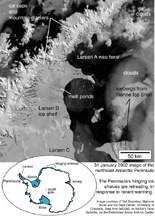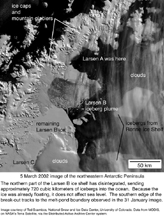

 annotated MODIS image, 31 Jan 2002 |
Between January 31st and March 7th, 3,275-square-kilometers of the Larsen B ice shelf disintegrated. While unusual in style, this event follows a pattern of retreat on this eastern Peninsula ice-shelf first identified by glaciologists from the Argentine Antarctic Institute. The break-up of the floating ice mass, which had survived thousands of years of climate variations, comes at the end of one of the warmest summers on record around the Antarctic Peninsula. The Larsen Ice Shelf has been under careful observation since 1995, when its northernmost sector collapsed in a similarly dramatic event. At the time, there was no obvious explanation for why an ice shelf should break apart into so many small pieces. The usual pattern is frequent, small iceberg calving events punctuated by infrequent, larger calving events. Perhaps even more remarkable is the uniqueness of these events within our current interglacial climate. The breakup events have allowed marine geologists access to the sub-ice shelf seafloor, where sediment layers reveal ocean-surface conditions over the millennia. That record indicates that the Larsen A had been in place for about the last 2000 years. The Larsen B is likely to have been significantly older, according to new results from Eugene Domack (Hamilton College, Clinton, NY), Glenn Berger (Desert Research Institute, University of Nevada), and Robert Gilbert (Queen's University, Canada), who sailed into the region this spring aboard the RV Nathanial B. Palmer (the U.S. NSF-supported research icebreaker). |
|
An international group of scientists has been investigating ice-shelf breakup events and all agree, regional climate warming is at the heart of the recent changes. Here in the Department of Geology at Portland State University, the focus is on how meltwater alters ice mechanics. Assistant professor Christina Hulbe and collaborators Ted Scambos (National Snow and Ice Data Center, Boulder, CO) and Mark Fahnestock (University of Maryland, College Park, MD) have come to the conclusion that what matters most about the warming is when it happens. In short: surface melt-water, generated during summers with long melt seasons, fills the otherwise air-filled crevasses (cracks) in the ice surface, and enables them to propagate through the full ice-shelf thickness. Thus weakened, the ice shelf is vulnerable to rapid break-up. Ice shelves are platforms of ice that go afloat where mountain glaciers and ice sheets flow from the land onto the ocean. The ice flows horizontally from its landward boundary (the grounding line) to its seaward front, where icebergs calve (break off). The speed of the ice depends on shelf thickness and temperature, and the geometry of the bay walls and islands past which it flows. The front of the Larsen B was moving seaward a little more than one meter per day after the 1995 calving event. At 65 degrees south latitude, the northern regions of the Larsen ice shelf system have been subject to a summertime warming trend for more than half a century. In November of 2001, Pedro Skvarka, of the Argentine Antarctic Institute, alerted Larsenophiles to the possibility of a large break-up event this year, due to unusually warm spring temperatures. |
 annotated MODIS image, 5 March 2002 |
It has long been recognized that ice shelves ought to be senstive to climate change. Since the mid-1970's, glaciologists studying Antarctica have considered the mean annual temperature to be a good indicator of ice-shelf stability. Warmer than -5 degrees Celcius, and ice shelves should retreat. Colder than -5 and they should be stable. But the ususal analyses of the forces involved in ice-shelf retreat are not likely to account for the unusual style of Larsen A's, and now Larsen B's, collapse. Moreover, the simple correlation between isotherms on a map and ice shelf front positions cannot be seen as more than coincidence without a physical mechanism to explain the connection.
We (Hulbe, Scambos, and Fahnestock) have used a combination of satellite-remote sensing and computer modeling to develop a theory linking summertime warming to break-up events. The connection is meltwater.
Satellite-based observations of melt-water ponds on the surface of the Larsen Ice Shelf's northern sectors in years leading up to break-ups, by Ted Scambos, provided the first evidence of the importance of surface meltwater. Mark Fahnestock used 20 years of passive microwave data to compute the length of the melt season on ice shelves all around the Antarctic Peninsula. Summers with the longest melt seasons were followed by break-up events.
Just how much ice is that?
volume of ice lost
handy scales of reference
|
The final step was to evaluate the roles meltwater could play in ice-shelf flow. Water is relatively warm, and so could be softening the ice, allowing it to flow more rapidly over time. But thermal diffusion proceeds slowly, and satellite-based mapping of ice shelf flow, conducted by Helmut Rott (Innsbruck University) and Wolfgang Rack (Alfred Wegener Institute, Bremerhaven, Germany) showed no unusual flow patterns around the collections of melt ponds.
A different, and more rapid, role for meltwater is in its ability to enhance crevasse propagation. The physics of this process was first studied by Hans Weertman in the late 1960's but it was not until Hulbe's modeling study that it was applied to the Peninsula ice shelf problem. When filled 90% or more, a sufficiently deep crevasse can overcome the overburden pressure that tends to close the crevasse at depth. In the case of the Larsen A and B, model inversions indicate that the critical initial crevasse depth is between about 6 and 15 meters, very modest values.
This season's dramatic events, coming at the end of an exceptionally warm summer when melt ponds were pervasive, provide a good test for the theory. Days before the final break-up, large meltponds are seen to contract, indicating that crevasses had cracked through the full thickness of the ice shelf and the surface water was begining to drain to the sea. The southern boundary of the embayment cut into the Larsen B tracks closely to the southernmost limit of surface meltponds seen in images leading up to the March event. Together, these observations lend strong support to the meltwater-crevasse propagation theory.
It should be noted that although several recent large iceberg calving events have been observed on the Ross Ice Shelf and elsewhere in Antarctica, none of these are thought to be related to ice shelf instability. The success of the summer melt-pond theory does, however, suggest that a re-assesment of other fringing ice shelves around Antarctica is needed.
Past assessments of ice-shelf stability have been based primarily on mean annual temperature. The importance of melt ponds indicates that mean summer temperature is a better guide. How do other ice shelves fare under this new criteria? The next shelf to the south, the Larsen C, is very near the stability limit, and may start to recede in coming decades if the observed warming trend continues. Ted Scambos and Mark Fahnestock are hard at work developing new data sets to extend the analysis farther.
other websites of interest
|
Scambos, T.A., Hulbe, C., Fahnestock, M., and Bohlander, J., 2000, The link between climate warming and break-up of ice shelves in the Antarctic Peninsula, Journal of Glaciology, 46 (154), 516-530.
Clapperton, C.M., 1990, Quaternary glaciations in the Southern Ocean and Antarctic Peninsula area, Quaternary Science Reviews 9, 229-252.
Doake, C.S.M. and D.G. Vaughn, 1991, Rapid disintegration of the Wordie ice shelf in response to atmospheric warming, Nature, 350, 328-330.
Domack, E., A. Leventer, R. Dunbar, F. Taylor, S. Brachfeld, C. Sjunneskog, 2001, Chronology of the Palmer Deep site, Antarctic Peninsula; a Holocene palaeoenvironmental reference for the circum-Antarctic, The Holocene, 11 (1), 1-9
Mercer, J.H., 1978, West Antarctic ice sheet and CO2 greenhouse effect: a threat of disaster, Nature, 271 (5643), 321-325.
Skvarka, P., 1994, Changes and surface features of the Larsen Ice Shelf, Antarctica, derived frm Landsat and Kosmos mosaics, Annals of Glaciology, 20, 6-12.
Vaughan, D.G. and C.S.M. Doake, 1996, Recent atmospheric warming and retreat of ice shelves on the Antarctic Peninsula, Nature, 379 (6563), 328-331.
Weertman, J., 1973, Can a water-filled crevasse reach the bottom surface of a glacier?, International Association of Scientific Hydrology Publication 95, 139-145.